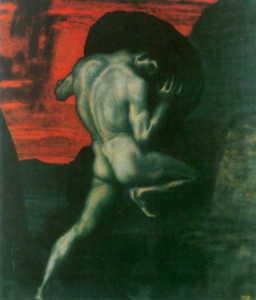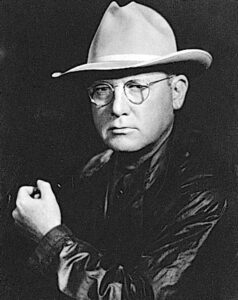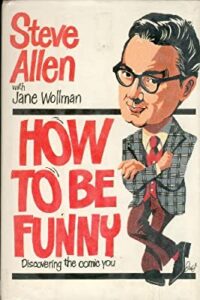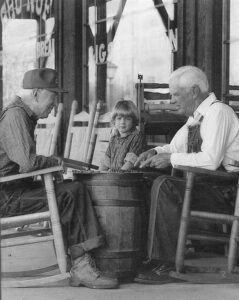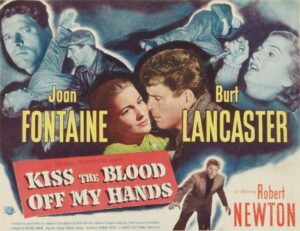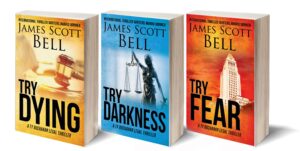by James Scott Bell
@jamesscottbell
 I love a good epigraph. That’s the quotation some authors put on a standalone page right before the novel begins. It is not to be confused with an epigram, which is a pithy and witty statement. However, if placed at the front of a book, an epigram becomes an epigraph, thus epitomizing epiphenomena (secondary effects).
I love a good epigraph. That’s the quotation some authors put on a standalone page right before the novel begins. It is not to be confused with an epigram, which is a pithy and witty statement. However, if placed at the front of a book, an epigram becomes an epigraph, thus epitomizing epiphenomena (secondary effects).
This is the epigraph from Mario Puzo’s The Godfather:
Behind every great fortune there is a crime. — Balzac
The purpose of an epigraph is one or more of the following:
- Hint at the theme of the novel.
- Help set the tone.
- Create curiosity about the content.
- Put a wry smile on the reader’s face.
Stephen King is positively giddy about epigraphs. He usually has two or more. Like in Cell, a novel about an electronic signal sent out over a global cell phone network. The signal turns those who hear it into mindless, zombie-like killers. Why? Perhaps by removing all psychological restraints, resulting in animalistic behavior. Here are King’s epigraphs:
The id will not stand for a delay in gratification. It always feels the tension of the unfulfilled urge. – Sigmund Freud
Human aggression is instinctual. Humans have not evolved any ritualized aggression-inhibiting mechanisms to ensure the survival of the species. For this reason man is considered a very dangerous animal. – Konrad Lorenz
Can you hear me now? – Verizon
That last one gave me a wry smile indeed. Here a few more examples:
TO KILL A MOCKINGBIRD by Harper Lee
Lawyers, I suppose, were children once. — Charles Lamb
FAHRENHEIT 451 by Ray Bradbury
If they give you ruled paper, write the other way. — Juan Ramón Jiménez
GONE GIRL by Gillian Flynn
Love is the world’s infinite mutability; lies, hatred, murder even, are all knit up in it; it is the inevitable blossoming of its opposites, a magnificent rose smelling faintly of blood. — Tony Kushner, THE ILLUSION
For my Mike Romeo thrillers, I use two epigraphs. Because Romeo is both classically educated and trained in cage fighting, I choose a quote from classic lit and something more contemporary. For example, here are the epigraphs for Romeo’s Way:
Sing, goddess, the wrath of Achilles … – Homer, The Iliad
Everybody has a plan until they get punched in the face. – Mike Tyson
How do I find a good epigraph?
First, brainstorm some of the topics and themes that apply to your novel, e.g.,
- Drug use among kids
- Criminal enterprises, darkness of
- Fighting to balance the scales of justice
- Chaos in the streets
- Hope in hopeless situations
- Is true love possible?
Next, think of your lead character’s strengths and weaknesses, such as:
- Will kick your butt if provoked
- Hard to trust other people
- Has an anger issue
- Has compassion for the weak
- Can’t stand injustice anywhere
With those in mind, you can being your search. I have big library of quote books, led by the venerable Bartlett’s Familiar Quotations. I also have “off the wall” collections that provide funny or ironic possibilities. Two of my faves are The Portable Curmudgeon by Jon Wikonur and 1,911 Best Things Anybody Ever Said by Robert Byrne.
There are online resources, of course, like The Quotations Page, which allows you to search by keyword and author.
So you look around and find several possibilities. Later, choose the best one. Save the others in a file for possible use in the future.
Can I make up an epigraph?
Well, some have. Dean Koontz made up many of his, and even a fictional source, The Book of Counted Sorrows. Readers and booksellers all over the world were stymied trying to find a copy of this rare tome. Koontz eventually copped to it, and even issued a short-term ebook version of it via Barnes & Noble. (If you want to read the epigraphs, you can do so here.)
I don’t advise this tactic, however. A reader may become frustrated trying to track down the quote on the internet. And who do you think you are anyway? Shakespeare?
Do I need permission to quote?
You do not need permission from a copyright holder to use a line or two from a published source. An epigraph is the very essence of fair use.
The one possible exception to this is song lyrics. Careful lawyers and nervous publishers will tell you to get permission. That is a long, laborious process that could end up costing you a fee. I’m not going to go into the whys and wherefores of the fair use doctrine, which you can find online (as here). I think an argument can be made for the fair use of a line from a song. See, e.g., this well-reasoned opinion. (Note: I dispense no legal advice in this post. Talk about being careful!) The risk-reward ratio may not be favorable for most writers.
Where do I place an epigraph?
On the page just before Page 1 of your novel. And note: an epigraph is not a dedication. If you use a dedication, the epigraph should follow, not precede it.
How many epigraphs can I use?
My rule of thumb is one or two. At most, three. More than that risks overburdening the reader and diluting the purpose.
With a book broken up into parts, you can put an epigraph before each part. If you’re feeling frisky you can use an epigraph for every chapter (!) as Stephen King does in one of his Bachman novels, The Long Walk.
Do I put quote marks around the epigraph?
No.
Do I italicize an epigraph?
It’s up to you. Either choice is fine. Just never italicize the source. E.g.,
The free-lance writer is one who is paid per piece or per word or perhaps. — Robert Benchley
What if I can’t find a good one?
When in doubt go to Shakespeare, the Bible, or Mark Twain.
Do readers really read epigraphs?
The true answer is that most probably don’t. Or else they just skim right past them on the way to the story. Which raises the question, is it worth the author’s time to hunt them down?
You have to answer that for yourself. My answer is yes. I like epigraphs and I’m happy to spend the extra time for the readers who like them as well.
Plus, after finishing a novel, my search for the perfect epigraph is like my gift to the book. The book has been with me since the idea phase, whispering sweet nothings in my ear, fighting me sometimes but always with its heart in the right place. I figure I owe the book a little something and a good epigraph is it.
Over to you now. Are you an epigraph fan? Have you used them yourself?

